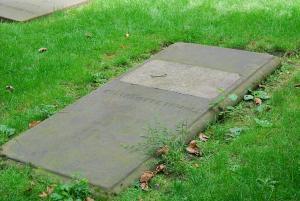The Mystery of Charlotte Temple
The grave.
Saturday's New York Timescarried coverage of an unusual event in Trinity Churchyard--an exploration of the ground underneath a vault stone. The sandstone slab, located in the north churchyard, is engraved with the name of famous eighteenth century fictional character: Charlotte Temple.
Charlotte Temple is the tragic protagonist of America’s first bestseller, Charlotte, A Tale of Truth,published here in 1794. It tells the story of an aristocratic English schoolgirl who is seduced by a British army officer. They flee to New York, where he leaves her pregnant and destitute. Charlotte gives birth to a daughter and dies and, according to legend, is buried in Trinity Churchyard.
Author Susanna Rowson claimed that Charlottewas a true story based on the life of Charlotte Stanley, granddaughter of the Earl of Derby, and Col. John Montresor, Rowson’s cousin. Historical evidence does not support this assertion. Trinity’s burial records from the time were destroyed by fire, and there is no record of Charlotte’s birth in England. The details of Montresor’s life also don’t match up with Rowson’s tale—-though, tantalizingly, he had connections to Trinity Church.
Whatever the truth, “Charlotte Temple” quickly became a celebrity, subject of plays and a touring exhibition of wax figures. No one knows for sure when or how the Charlotte Temple grave appeared in Trinity Churchyard. An 1829 letter to the editor of the New York Daily Advertiserasks for information about the location of the stone, which the writer was unable to find. By 1855, however, stories about throngs of weeping visitors were a fixture in New York newspapers. The present Trinity Church was built in the intervening years, and there is evidence to suggest that “Charlotte Temple” was carved into the grave during the construction process.
Questions remain. The Charlotte Temple stone has a rectangular indentation that has been cemented over. It could have originally held a plaque. Was there a plaque, and did it list, as the legend asserts, Charlotte Stanley’s name, place of birth, and the name of her betrayer? Or was it the grave of someone unrelated to Rowson’s novel? Was "Charlotte Temple" carved into the stone in good faith, or was it a joke?
The vault stone bearing the name Charlotte Temple was lifted to determine if there was, in fact, a vault underneath--and if the vault had any markings that would yield clues to the true identity of the person buried there. Unfortunately, no vault was found--so the mystery remains.
